
Lake Huron is one of the five Great Lakes of North America. Hydrologically, it comprises the easterly portion of Lake Michigan–Huron, having the same surface elevation as Lake Michigan, to which it is connected by the 5-mile-wide (8.0 km), 20-fathom-deep Straits of Mackinac. It is shared on the north and east by the Canadian province of Ontario and on the south and west by the U.S. state of Michigan. The name of the lake is derived from early French explorers who named it for the Huron people inhabiting the region.
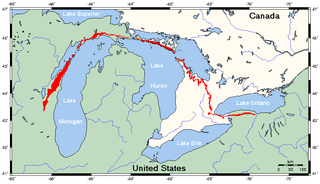
The Niagara Escarpment is a long escarpment, or cuesta, in Canada and the United States that runs predominantly east–west from New York through Ontario, Michigan, Wisconsin, and into Illinois. The escarpment is the cliff over which the Niagara River plunges at Niagara Falls, for which it is named.
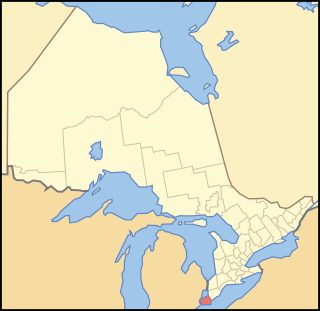
Essex County is a primarily rural county in Southwestern Ontario, Canada comprising seven municipalities: Amherstburg, Kingsville, Lakeshore, LaSalle, Leamington, Tecumseh and the administrative seat, Essex.

Bruce County is a county in Southwestern Ontario, Canada. It has eight lower-tier municipalities with a total 2016 population of 66,491. It is named for James Bruce, 8th Earl of Elgin and 12th Earl of Kincardine, the sixth Governor General of the Province of Canada. The Bruce name is also linked to the Bruce Trail and the Bruce Peninsula.
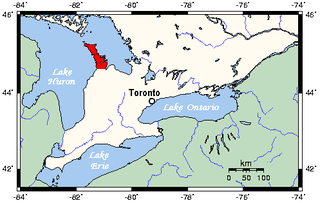
The Bruce Peninsula is a peninsula in Ontario, Canada, that divides Georgian Bay of Lake Huron from the lake's main basin. The peninsula extends roughly northwestwards from the rest of Southwestern Ontario, pointing towards Manitoulin Island, with which it forms the widest strait joining Georgian Bay to the rest of Lake Huron. The Bruce Peninsula contains part of the geological formation known as the Niagara Escarpment.
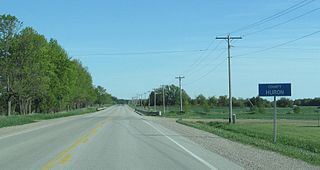
Huron County is a county of the province of Ontario, Canada. It is located on the southeast shore of its namesake, Lake Huron, in the southwest part of the province. The county seat is Goderich, also the county's largest community.

The ExPlace Wind Turbine is a 91-metre (299 ft) tall wind turbine located on the grounds of the Exhibition Place co-owned by the WindShare for-profit co-operative and Toronto Hydro. It is the first wind turbine installed in a major North American urban city centre, and the first community-owned wind power project in Ontario. WindShare itself was officially launched in February 2002 in Toronto, Ontario, Canada. It was created by the non-profit Toronto Renewable Energy Co-operative (TREC) which was incorporated in 1998. TREC continues to exist as a separate non-profit entity.

St. Paul's Cathedral in London, Ontario, Canada, is the seat of the Diocese of Huron of the Anglican Church of Canada. It was designed in the Gothic revival style by William Thomas and built between 1844 and 1846, replacing the previous church, which was built in 1834 and burned down in 1844. It is the oldest church in the city. Sculptors John Cochrane and Brothers undertook the work on the cathedral's interior.
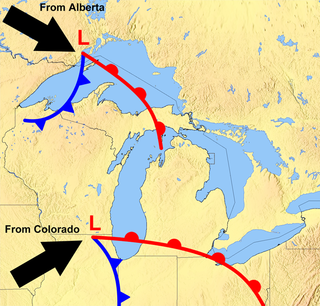
The Great Lakes Storm of 1913 was a blizzard with hurricane-force winds that devastated the Great Lakes Basin in the Midwestern United States and Southwestern Ontario, Canada, from November 7 to 10, 1913. The storm was most powerful on November 9, battering and overturning ships on four of the five Great Lakes, particularly Lake Huron.
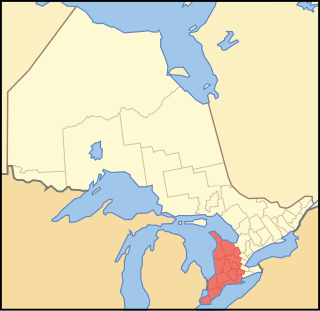
Southwestern Ontario is a secondary region of Southern Ontario in the Canadian province of Ontario. It occupies most of the Ontario Peninsula bounded by Lake Huron, including Georgian Bay, to the north and northwest; the St. Clair River, Lake St. Clair, and Detroit River, to the west; and Lake Erie to the south. To the east, on land, Southwestern Ontario is bounded by Central Ontario and the Golden Horseshoe. The region had a population of 2,583,544 in 2016. It is sometimes further divided into "Midwestern Ontario" covering the eastern half of the area and the heart of Southwestern Ontario encompassing the western half of the region.
Kingsbridge Wind Power Project, also referred to as Kingsbridge 1 Wind facility , refers to a large wind farm owned and operated by Capital Power Corporation. Kingsbridge 1 Wind facility is located between Goderich and Kincardine, Ontario. The Kingsbridge 1 Wind facility is located on the southeast shore of Lake Huron in the township of Ashfield-Colborne-Wawanosh and consists of 22 1.8 MW Vestas V80 wind turbines with a capacity of 39.6 MW. Each tower is over 78 meters tall and weigh around 195 metric tonnes. The project consists of two phases and currently provides power to on average 12,500 homes.

Inverhuron is a community located in Bruce County within the Municipality of Kincardine in the Canadian province of Ontario. The community includes approximately 200 permanent residents and 400 seasonal cottagers.

The 1996 Lake Huron cyclone, commonly referred to as Hurricane Huron and Hurroncane, was an extremely rare, strong cyclonic storm system that developed over Lake Huron in September 1996. The system resembled a subtropical cyclone at its peak, bearing some characteristics of a tropical cyclone. It was the first time such a storm has ever been recorded forming over the Great Lakes region.
The Ripley Wind Power Project is a 76 megawatt (MW) wind power project near Ripley, Ontario.

Huron-Kinloss is a township in the Canadian province of Ontario, located within Bruce County. The township had a population of 7,069 in the Canada 2016 Census.
The Underwood Wind Farm is a wind farm located in Bruce County, Ontario, near the shores of Lake Huron. It was developed by Enbridge Inc., a Canadian corporation better known for involvement in fossil fuels and their distribution.
Bruce Herbert Warren Howe was the 4th coadjutor bishop of Huron who later became its diocesan.
King's Highway 83, also known as Highway 83, was a provincially maintained highway in the Canadian province of Ontario. The route travelled inwards from the shores of Lake Huron, beginning at Highway 21 north of Grand Bend and travelling eastward to Highway 23 in Russeldale. Today the route is known by the local names Dashwood Road and Thames Road, as well as by county-assigned designations Huron County Road 83 and Perth County Road 20.
The London, Huron and Bruce Railway (LH&BR) was a short line railway in Ontario, Canada. It started in London, Ontario, running northward for 70 miles (110 km) to the small town of Wingham. It originally planned to continue north to Southampton or Kincardine, but instead joined the Wellington, Grey and Bruce Railway (WG&BR) at Wingham. The route was primarily used for farm shipments, and was nicknamed the "Butter and Egg Special", while passengers complaining about the rough ride constructed the backronym "Let 'er Hit and Bounce".
The Wellington, Grey and Bruce Railway (WG&BR) was a railway in Ontario, Canada. It ran roughly northwest from Guelph to the port town of Southampton on Lake Huron, a distance of 101 miles (163 km). It also had a 66-mile (106 km) branch line splitting off at Palmerston and running roughly westward to Kincardine, another port town. A branch running south from Southampton was built during the construction of the Bruce Nuclear Generating Station in the 1970s.














